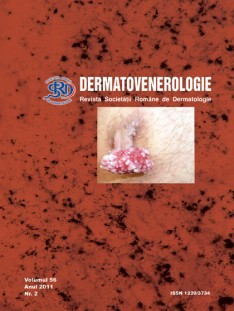Studii clinice si experimentale
Particularitati morfofiziologice ale tegumentului imbatranit: diferente morfofiziologice legate de sex
Pielea reprezinta unul dintre cele mai mari organe din corpul uman si, la fel ca si alte þesuturi, sufera procese degenerative de-a lungul timpului. Pielea reprezinta cel mai important organ la care sunt vizibile modificarile legate de varsta. Imbatranirea tegumentului este asociata cu o rata crescuta de boli ale pielii, inclusiv tumori cutanate si cu stres psihologic important. In ultima perioada, urmarirea imbatranirii tegumentului a dobandit importanþa majora in cadrul patologiei legate de senescenþa.
Studiul de faþa isi propune realizarea unei comparaþii intre particularitaþile morfofiziologice ale tegumentului imbatranit in funcþie de sex.
Lotul de studiu a constat din 180 de pacienþi cu varsta peste 60 ani, internaþi pe o perioada de 1 an (2008-2009) in Spitalul de Dermato-Venerologie Timisoara – 89 pacienþi (49,44%) au fost de sex masculin si 91 (50,55%) de sex feminin.
S-a urmarit frecvenþa apariþiei si preponderenþa in funcþie de sex in lotul de studiu a 20 de boli cutanate care afecteaza persoanele varstnice: modificarile trofice din insuficienþa venoasa cronica, dermatita eczematiforma, eczema endogena, epiteliomul bazocelular, psoriazisul vulgar, prurigo-ul, urticaria, Zona Zoster, eczematidele, lupusul eritematos diseminat, lichenul plan, keratoza seboreica, carcinomul spinocelular, cornul cutanat, verucile seboreice, celulita erizipeloida, vasculita nodulara, eritemul polimorf, limfomul cutanat si a trei parametri asociaþi bolilor respective ca diagnostice secundare: hipertensiunea arteriala, diabetul zaharat si obezitatea.
Din ansamblul populaþiei varstnice studiate se poate observa un tip de pacient cu risc crescut – femeie cu varsta intre 80 si 90 ani, care traieste singura, si acolo unde exista asociere cu alte stari morbide.
Studiul de faþa isi propune realizarea unei comparaþii intre particularitaþile morfofiziologice ale tegumentului imbatranit in funcþie de sex.
Lotul de studiu a constat din 180 de pacienþi cu varsta peste 60 ani, internaþi pe o perioada de 1 an (2008-2009) in Spitalul de Dermato-Venerologie Timisoara – 89 pacienþi (49,44%) au fost de sex masculin si 91 (50,55%) de sex feminin.
S-a urmarit frecvenþa apariþiei si preponderenþa in funcþie de sex in lotul de studiu a 20 de boli cutanate care afecteaza persoanele varstnice: modificarile trofice din insuficienþa venoasa cronica, dermatita eczematiforma, eczema endogena, epiteliomul bazocelular, psoriazisul vulgar, prurigo-ul, urticaria, Zona Zoster, eczematidele, lupusul eritematos diseminat, lichenul plan, keratoza seboreica, carcinomul spinocelular, cornul cutanat, verucile seboreice, celulita erizipeloida, vasculita nodulara, eritemul polimorf, limfomul cutanat si a trei parametri asociaþi bolilor respective ca diagnostice secundare: hipertensiunea arteriala, diabetul zaharat si obezitatea.
Din ansamblul populaþiei varstnice studiate se poate observa un tip de pacient cu risc crescut – femeie cu varsta intre 80 si 90 ani, care traieste singura, si acolo unde exista asociere cu alte stari morbide.


